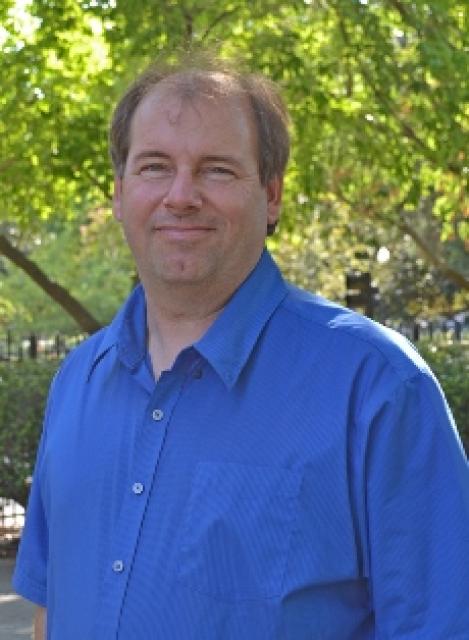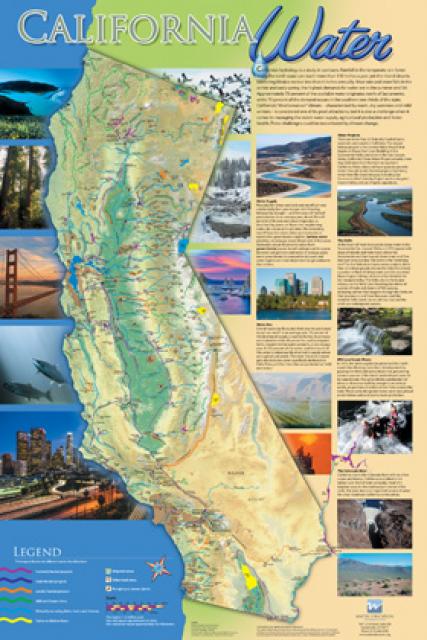California Project WET Gazette
Winter 2024
Project WET and Teaching Practices
“The teacher must derive not only the capacity, but the desire, to observe natural phenomena. The teacher must understand and feel her position of observer: The activity must lie in the phenomenon.” — Maria Montessori
Welcome to 2024, Project WET Educators! This will be a year of transition as Project WET Guide 2.0 is replaced by the first of four new guides. The “Foundations in Water Education” guide should be rolling out in mid-February followed by the “Water & Earth Systems” guide by fall.
The new guides are expected to have some very welcome updates and much-needed changes as detailed in the Autumn 2023 Gazette, and every one of them involved much debate among educators nationwide.
One of the still-smoldering debates is over the setup of Project Wet activities. Should teachers pose questions or provide students with background on the natural phenomenon in advance of the activity? Some educators favor this traditional approach, arguing that it “primes the pump” of student curiosity and indicates what they already know about the phenomenon.
Other educators contend students learn more if the questions are self-generated. They say students should just dive right into activities because the built-in scenario or simulation of observable events found in most of the exercises are designed to engage their curiosity and elicit questions. Any gaps in their knowledge will prompt their questions and drive the learning that flows from the activity.
Questions vs. Phenomena
Advocates of the latter approach also strongly object to the way some educators characterize their warm-up questions as the “phenomenon” rather than the actual event they are trying to frame. As one California pre-service professor in this camp recently noted, the definition of phenomenon is very clear – it’s an observable event or instance in the natural world or human-made world. Period.
I agree. Phenomena are not questions. A storyline or case study can serve as an observable event. Many Project WET activity scenarios are designed to engage students in an observable event and prompt questions.
The Thunderstorm Phenomenon
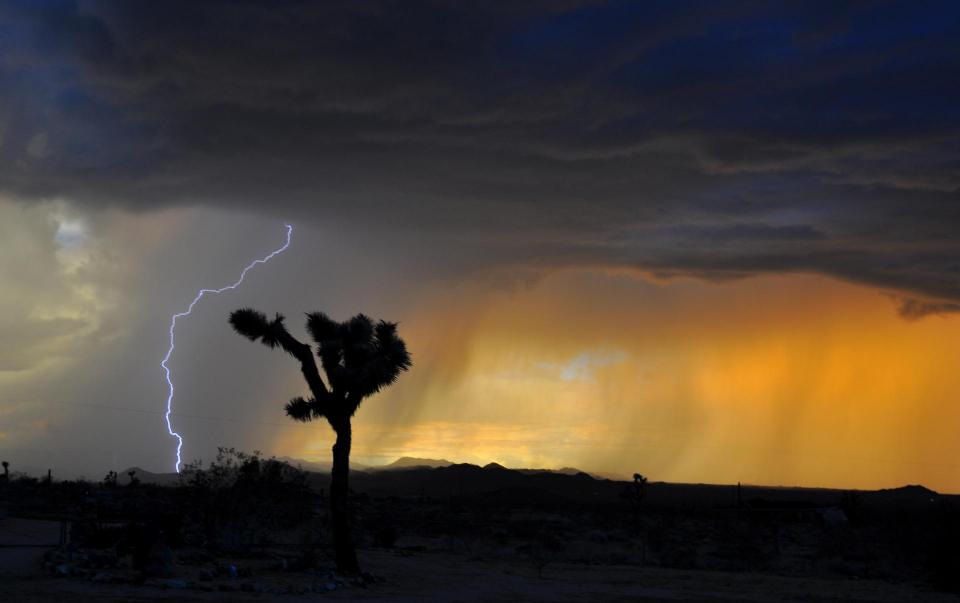 “The Thunderstorm” (p. 209) serves as an example. The warm-up exercise has the teacher reading a simulated National Weather Service warning and asking students to describe how they would feel hearing it on their car radio and what precautions they would take.
“The Thunderstorm” (p. 209) serves as an example. The warm-up exercise has the teacher reading a simulated National Weather Service warning and asking students to describe how they would feel hearing it on their car radio and what precautions they would take.
I have found that students learn more about a phenomenon if they set the stage themselves. That is what “The Thunderstorm” activity itself does. Teachers can skip the warm-up and dive right into the activity that begins with the teacher leading the class in simulating the sounds and sights of a thunderstorm and challenging them to guess what natural event they are mimicking.
I’ve never had a class fail to figure out we are simulating a thunderstorm, ask questions about the real-life event, and share their thunderstorm experiences – all key elements for the rest of the activity – with little or no prompting on my part.
Students can share their experiences in a “Tales of the Thunderstorm” writing project as suggested in the Project WET activity. These experiences usually bring up questions about safety during a storm.
The sharing of thunderstorm experiences seems to me to be the most logical place in the activity to address how students can protect themselves from these weather events, including how to use the sound of thunder to estimate the distance from a storm.
When I taught science outdoors, I borrowed from the K-2 suggestions and challenged students to connect what we did in our simulation to their knowledge of the water cycle. I asked them to sketch out how a thunderstorm might form and progress. This always led to questions on how thunderstorms are different than other storms and how the storms can generate lightning and under.
When Using Examples, Go Local
Integrating local water issues or topics into the learning models of Project WET activities still seems to elude many people.
But opportunities for localizing activities abound. The big questions always floating around the California water world are when or if the winter rain and snow will arrive, where will it fall, and how much? Part ll of “The Thunderstorm” addresses where and how much with a simulated storm and students acting as a precipitation monitoring network.
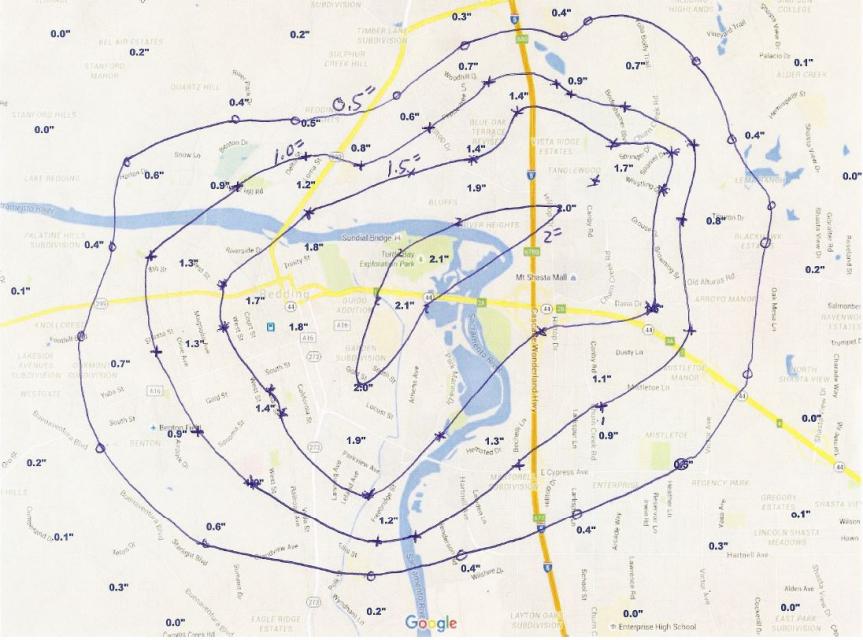 Years ago, an after-school educator did this simulation with middle school students. Students built their own rain gauges and used them to measure rainfall at home during the next storm.
Years ago, an after-school educator did this simulation with middle school students. Students built their own rain gauges and used them to measure rainfall at home during the next storm.
The class plotted their rainfall totals on a map of the town and used the isohyet line mapping skills learned in the Project WET activity to approximate where and how much rain fell in their community. The learning continued from there, but you get the idea: Local phenomena can be used to get across the concepts and apply the skills in Project WET activities.
Educators around California have shared with me how “The Thunderstorm” sparked student precipitation monitoring networks. Some schools have gone on to join the Community Collaborative Rain, Hail & Snow Network, a grassroots group of weather observers of all ages who measure and map precipitation in communities across the country.
The data in this program is used for water management, education and research applications, allowing students to contribute to the larger community and making what they learn meaningful and more memorable.
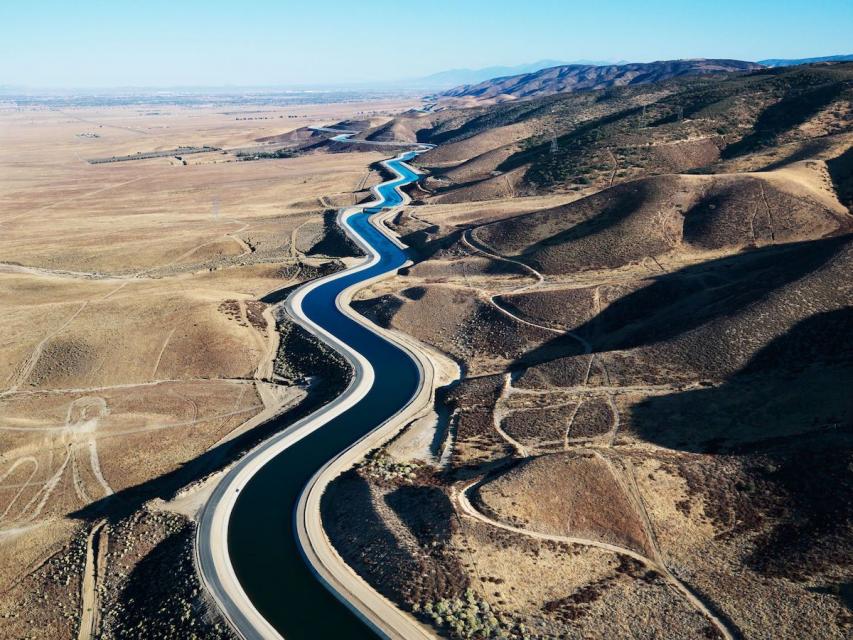 “The Long Haul” (p. 273) provides another example of a Project WET activity with an embedded phenomenon related to current California water challenges. Using the new version of the activity that emerged from the COVID pandemic lockdown, student teams compete to design ways to transport water from variously located sources to the community water reservoirs.
“The Long Haul” (p. 273) provides another example of a Project WET activity with an embedded phenomenon related to current California water challenges. Using the new version of the activity that emerged from the COVID pandemic lockdown, student teams compete to design ways to transport water from variously located sources to the community water reservoirs.
Graphing the results from the simulation, students observe how distance from water sources affects a community’s ability to secure adequate water supplies. Students are also challenged to consider how other factors such as purchasing power or political representation affect access to safe and reliable water supplies.
All these factors emerge in discussions on the future of the Sacramento-San Joaquin Delta. It is the hub of California’s water delivery system and a vital ecological and agricultural region with shipping channels and hundreds of natural gas lines and key high-voltage transmission lines.
Any proposal affecting the flow of water through the Delta brings the attention of all these groups to bear. This is particularly true for the proposed Delta Conveyance Project, which re-entered the news this month when the state Department of Water Resources approved the project’s final environmental impact report.
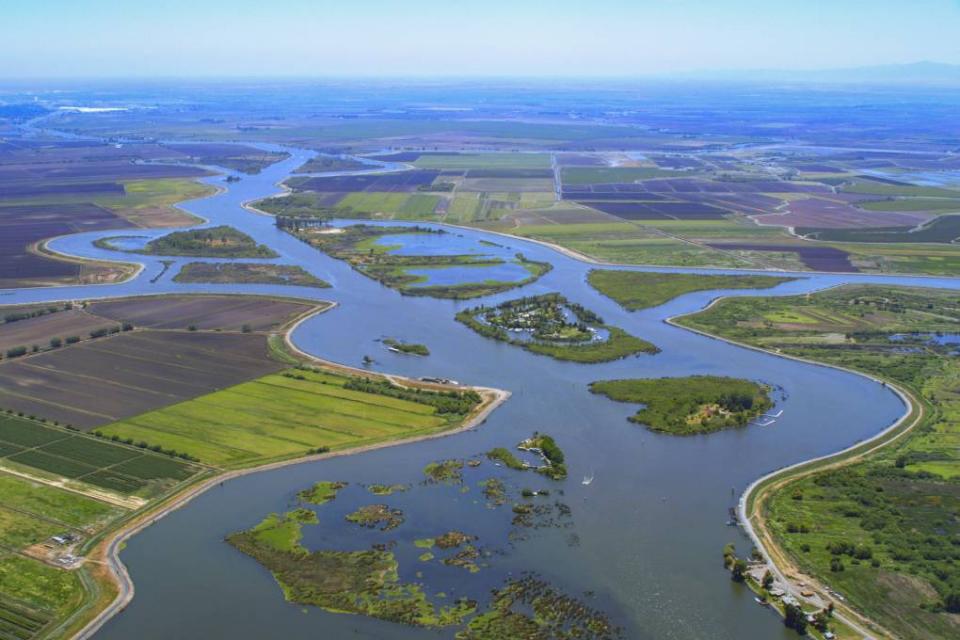 Using “The Long Haul” as the phenomenon to engage student interest and generate questions on factors affecting water supply and access is a great lead into the Project WET activity “8-4-1, One For All” (p. 299) – soon to be updated with the title, “Water For All.” The activity provides a great template for students to break down how the changes resulting from the proposed Delta Conveyance Project may affect the array of interests involved and shape their views.
Using “The Long Haul” as the phenomenon to engage student interest and generate questions on factors affecting water supply and access is a great lead into the Project WET activity “8-4-1, One For All” (p. 299) – soon to be updated with the title, “Water For All.” The activity provides a great template for students to break down how the changes resulting from the proposed Delta Conveyance Project may affect the array of interests involved and shape their views.
Students can be broken into groups to investigate the complexity of views on Delta conveyance. For example, how do the views of municipal interests differ between those dependent on Delta water and those who aren’t? Can students see patterns to form a matrix of views that can help develop possible solutions that could benefit all?
Check out Websites of Interest for links to a variety of articles and viewpoints on the Delta Conveyance Project and the questions of how to better forecast and monitor precipitation in California.
Visit the Professional Development Opportunities for upcoming workshops and summer institutes to learn more about an array of water topics and challenges within our state. You’ll also find Winter Events to tie into your use of Project WET activities – or to simply enjoy – plus a roster of Grants, Scholarships & Awards and Student Contests available in early 2024!
WEBSITES OF INTEREST
InTeGrate:Teach with Local Examples and Data
The nature of working with local examples engages students since it builds on their sense of place and can help students make connections between what they learn and their everyday experiences. Working in the local environment couples this applied knowledge with an opportunity to improve upon skills such as working with field equipment, critical thinking, and teamwork.
U.S. Geological Survey: National Water Dashboard
The National Water Dashboard is a mobile, interactive tool that provides real-time information from more than 13,500 USGS observation stations across the country — all in one place on a computer, smartphone or other mobile device. It is a fantastic site for accessing local data to integrate into “The Thunderstorm,” ”Blue River” and other Project WET activities that include weather and water data.
National Water and Climate Center: Snow and Water Interactive Map
This map displays current and historic data in an easy-to-use, visual interface. The information comes from the Natural Resources Conservation Service manually collected snowpack and precipitation data, automated Snow Telemetry (SNOTEL) and Soil Climate Analysis Network (SCAN) stations. Check out the WET activity “Snow and Tell” (p. 387) to engage students in a simulation of the SNOTEL data collection process.
Community Collaborative Rain, Hail and Snow Network
This is a network of local volunteers of all backgrounds and ages working together to measure and map precipitation. Users of our data include the National Weather Service, hydrologists, engineers, utilities (water supply, water conservation, stormwater), emergency managers, ranchers and farmers, teachers, and students in the community. Another great site for getting local data to integrate into “The Thunderstorm.“
SFGATE: Major weather shift predicted in California before Christmas
Meteorologists are closely watching long-range forecasts that suggest California could see a dramatic weather shift in the second half of December. “It has been pretty dry in California for the last month or so. … But I still think that is very likely to change perhaps pretty quickly and dramatically, at some point toward the end of December, so mid-to-late December, and very likely by January,” UCLA climate scientist Daniel Swain said in a recent weather update posted on YouTube.
Water Education Foundation: Atmospheric Rivers
Atmospheric rivers are relatively narrow bands of moisture that ferry precipitation across the Pacific Ocean to the West Coast and are key to California’s water supply. They are commonly referred to as the “Pineapple Express” because of their origins in tropical regions.
USA Today: The weather is getting cold. Global warming is still making weather weird
Notoriously fickle, the world’s weather is lurching from one extreme to another more often and to a greater degree as the warming atmosphere pushes natural variability to new extremes, breaking records time and again, the researchers say. The increasing extremes aren’t just setting records, said Daniel Swain, a climate scientist at the University of California, Los Angeles. “They’re shattering records.”
Los Angeles Times: Blizzards, tornadoes and a hurricane: We lived through SoCal’s year of weird weather
How to describe the weather in Southern California this year? All that rain? That snow? Spring floods and a summertime hurricane? “Distinctly different,” says Daniel Swain, a UCLA climate scientist who chooses his words carefully. Maybe it was more than different. As the rest of the planet followed a predictable if worrisome pattern, setting records for heat and rising sea levels, Southern California didn’t know which way to turn. It was downright weird.
San Francisco Chronicle: El Niño cycles could become more predictable. Here’s why it matters for California
Much like a back-and-forth dance, the cycle between El Niño and La Niña will last about four years in a warmer climate, Brandon Molina, lead scientist on the study and his colleagues find. The transition from El Niño to La Niña conditions is currently more reliable to forecast than from La Niña to El Niño. The scientists find that both transitions will be equally predictable in the future.
Eos: Weather and Watershed Forecasting Make for Dam Smart Water Use
Together with partner agencies and institutions, the US Army Corps of Engineers launched the Forecast-Informed Reservoir Operations (FIRO) program. A successful pilot study of FIRO at Lake Mendocino from 2014 to 2020 demonstrated that FIRO increased water storage by nearly 20% compared with standard, non-FIRO operations. New research is further advancing efforts to improve the efficiency of U.S. reservoir operations.
Water Education Foundation: Exploring the Heart of California Water
The Delta is where California’s two great rivers – the Sacramento and the San Joaquin – converge to form the largest freshwater tidal estuary on the West Coast. Water that flows into the Delta largely originates as snowmelt and rain that fall in the Sierra Nevada. Water that moves through the Delta supplies drinking water to more than two-thirds of the state’s residents and irrigates more than 3 million acres of farmland.
California Department of Water Resources: Delta Conveyance Project
The Delta Conveyance Project is a proposal to modernize water infrastructure in the Sacramento-San Joaquin Delta by making physical improvements to how we capture and move water during wet years for use in dry years with a tunnel system. The proposed Delta Conveyance Project is intended to restore the reliability of the State Water Project and is protected from earthquakes and climate-driven weather extremes for the 27 million people and 750,000 acres of farmland that depend on it.
Mavens Notebook: REACTIONS: What agencies and stakeholder groups are saying about the final EIR for the Delta Conveyance Project
On Dec. 8, 2023, the Department of Water Resources released the final Environmental Impact Report for the Delta Conveyance Project. Click here to see the reactions of water agencies and other stakeholders to the Delta Conveyance Project final Environmental Impact Report.
Los Angeles Times: LA County aims to collect billions more gallons of local water by 2045
Over the next two decades, Los Angeles County will collect billions more gallons of water from local sources, especially storm and reclaimed water, shifting from its reliance on other region’s water supplies as the effects of climate change make such efforts less reliable and more expensive.
Water World: California celebrates over 100 water system consolidations since 2019
Westside Elementary serves about 350 K-6 students from disadvantaged backgrounds. Before its consolidation into the Coachella Valley Water District, Westside Elementary relied on contaminated well water. The consolidation was made possible by the State Water Board’s Safe and Affordable Funding for Equity and Resilience drinking water program.
Colorado Sun: 24 ideas floated for saving water and protecting Colorado River from drought, climate change
The Colorado River Drought Task Force’s job has been to identify new policies and tools to help save water and ensure neither Colorado water users nor the environment are adversely affected by any new federal Colorado River agreements designed to protect the drought-strapped river across the seven-state region where it flows.
California WaterBlog: California water ideas that deserve more attention
Water ideas are frequently discussed for improving and adapting California management to meet current and future challenges. Some ideas seem to receive too much attention, and others receive too little attention. For this post, we solicited ideas from some UC Davis Center for Watershed Sciences members that seem to deserve more attention.
California Department of Water Resources: Education
We provide a variety of resources to K-12 educators – including parents – to encourage water education in and out of the classroom. Our free supplementary materials can be used to help learn about California’s water resources. Check out our ‘Water Wednesdays’ YouTube page for a recording of our weekly conversations with DWR researchers on a range of water topics.
U.S. Geological Survey: Water Science School
The Water Science School offers educational resources for all who wish to learn about water. Instructors and students may find useful content to aid in their quest to discover all there is to know about our most precious resource, water. Browse thousands of ideas for using these resources in elementary, secondary, university and informal education settings and loaded with great materials for use with multiple Project WET activities!
PROFESSIONAL DEVELOPMENT OPPORTUNITIES
California Project WET Workshops
Join us this winter for workshops on Kern County water resources, a Getting Little Feet WET workshop for early learner educators in Shasta County with Project Learning Tree or a workshop and treatment plant tour for Contra Costa County educators. Click on the linked title to find out about upcoming workshops throughout the state.
California Project Learning Tree Workshops
Project Learning Tree uses trees and forests as windows on the world to increase students’ understanding of the environment and actions they can take to conserve it. Join us on February 4th in Redding for a combined PLT and Project WILD workshop for Early Learner educators and click here to check out other upcoming events!
California Project WILD Workshops
If you are a Shasta County teacher, join us for a Growing Up WILD workshop on Jan. 27 that explores children’s understanding of nature and invites them to explore wildlife and the world around them. This is a FREE event and lunch will be included. Visit our website to find your local California Project WILD Coordinator.
California Water Institutes for Teachers
Each institute is a multi-day professional development experience for K-12 educators focusing on the water resources serving the local area of the institute while providing teachers with tools and greater knowledge to engage students in developing their environmental literacy about the places where they live. Participants will receive Project WET training and opportunities to earn continuing education credit and a stipend.
California Environmental Education Interagency Network
This is a consortium of environmental educators representing state departments and partner organizations. Educators can find a variety of workshops and other participatory opportunities on our online events calendar to increase their environmental literacy on California natural resource topics and issues.
Forestry Institute for Teachers
Registration is open for the Forestry Institute for Teachers 2024 summer sessions! At FIT, cohorts of educators work alongside natural resource professionals and credentialed instructors to explore the complexities of stewarding our forest ecosystems for current and future generations. PreK-12 educators of all subject matters and teaching settings are encouraged to participate.
The registration fee covers food, lodging and teaching materials. Participants receive 50 hours of interdisciplinary instruction, certification in Project WET and Learning Tree — and upon program completion become eligible for a $300 stipend, 3 Continuing Education Units (CEUs) and future specialized FIT professional learning opportunities!
WINTER EVENTS
Jan. 11-12 & Feb. 9: California King Tides Project
The California King Tides Project helps to visualize future sea levels by observing the highest tides of today. You can help by taking and sharing photos of our shorelines during king tide events to create a record of changes to our coast and estuaries – including inland in tidally influenced areas of the Delta.
Jan. 15: National Parks Free Entrance Day
Dr. Martin Luther King Jr. was a tireless advocate for racial equality, working classes, and the oppressed around the world. In honor of the birthday of Martin Luther King Jr., national parks will waive entrance fees for everyone on this day. It is also a day of service when thousands of volunteers participate in service projects across the country.
Jan. 25-28: Snow Goose Festival of the Pacific Flyway
Join us in the search for winter birds of the Pacific Flyway with 4-days of action-packed events celebrating the remarkable journey of millions of waterfowl and raptors that call the Northern Sacramento Valley their winter home. Choose from more than 50 field trips that are sure to appeal to a wide variety of interests and ability levels.
Feb. 2: World Wetlands Day
The 2024 theme is ‘Wetlands and Human Well-being.’ Nearly 90% of the world’s wetlands have been degraded since the 1700s, and we are losing wetlands three times faster than forests. Wetlands are critically important ecosystems that contribute to biodiversity, climate mitigation and adaptation, freshwater availability, world economies and more.
Feb. 9-10: California STEAM Symposium
Join us in Long Beach for a symposium providing a brave space for exploring equity in STEAM learning, particularly for underrepresented populations we seek to grow in STEAM: educators and students of color, girls, multilingual learners, foster youth, unsheltered students, LGBTQIA+, low socio-economic students, and those with special learning needs.
Mar. 8-10: California Council for the Social Studies Conference
The 2024 CCSS conference will support social studies educators to work alongside students in building inclusive democratic spaces and narrating tomorrow’s history with the theme “Our Voices, Our Stories: Developing Community & Belonging Across the Social Studies.”
Mar. 11-17: Fix a Leak Week
Leaks Can Run, but They Can’t Hide! Household leaks can waste nearly 1 trillion gallons of water annually nationwide. Join us for a week hunting down the drips – but you can find and fix leaks inside and outside your home to save valuable water and money all year long!
Mar. 22: World Water Day
Water can be a tool for peace but it can also spark and intensify conflict when access is denied and usage unfairly shared. World Water Day 2024 theme “Leveraging Water for Peace” is about working together to balance everyone’s needs, with a dedication to ensure no one is left behind, to make water a catalyst for a more peaceful world.
SCHOOL GRANTS & AWARDS
California has created innovative access programs for children and families to explore California’s State Park System. With the new California State Park Adventure and State Library Parks pass programs and a revamped Golden Bear Pass Program, California is promoting a healthier, more equitable California for all.
President’s Environmental Youth Award: Due Jan. 15
The PEYA award recognizes outstanding environmental projects by K-12 youth. Encourage your students with an environmental stewardship project or an idea for a project to apply. Applicants from all 50 states as well as U.S. territories are eligible.
Presidential Innovation Award for Environmental Educators: Due Jan. 15
The award recognizes outstanding kindergarten through grade 12 teachers who employ innovative approaches to environmental education and use the environment as a context for learning for their students. Teacher awardees will receive a Presidential award plaque and an award of up to $2,500 to be used to further the recipient’s professional development in environmental education.
Climate Resilient Schools Program: Due Jan. 19
School districts, state and local governments, and Tribes are invited to send letters of interest to the 2024 Climate Resilient Schools program. This program is not a grant – funding will not be given directly to school districts or state/local/Tribal governments. EPA and a contractor will provide technical assistance to up to four school districts to support climate-resilient school buildings.
Whole Kids Foundation – Garden Grant Program: Opens in Feb.
Through the Garden Grant Program, outdoor spaces can be turned into gardens that engage in hands-on learning opportunities and connect students to their food source. The Whole Kids Foundation is awarding $3,000 grants to K-12 schools or non-profit organizations that serve K-12 students to support new or existing edible educational gardens.
Kids to Parks Day School Grants Program: Due Feb. 2
As a part of the Kids to Parks Day celebration on May 18, 2024, the National Park Trust is offering our Kids to Parks Day School Grants Program. Open to students from US/US territories-based Title 1 schools (40% of students qualify for free or reduced-price lunch) in grades PreK through 12, this grant program provides classrooms with up to $500 for distance learning experiences or up to $1,000 for in-park experiences.
Presidential Awards for Excellence in Math and Science Teaching: Due Feb. 6
The Presidential Awards for Excellence in Mathematics and Science Teaching are the nation’s highest honors for teachers of mathematics and science. Awardees reflect the expertise and dedication of the Nation’s teaching corps, and they demonstrate the positive impact of excellent teachers on student achievement. This year’s awards will honor science teachers working in grades K-6.
Toshiba America Foundation Grant 6-12: Due Mar. 1
Do you teach in a middle and high school classroom and have an innovative idea for improving STEM (Science, technology, engineering and math) learning in your classroom with measurable outcomes? Sixth to 12th-grade teachers are invited to apply online for a Toshiba America Foundation grant of up to $5,000 to help bring an innovative project into their classroom.
Early Childhood Education Grants: Due Apr. 1
The Frances R. Dewing Foundation supports innovation in early childhood education and accepts applications from U.S.-based and operating 501(c)(3) nonprofit organizations and government entities such as schools and school districts. The foundation provides seed money in the form of small grants, generally ranging from $1000 to $25,000.
Karma for Cara Microgrant Program: Due Apr. 1
The K4C Microgrant Program is the bridge between ideas and action, helping young citizen leaders execute and magnify their initiatives to help repair our world. Students 18 years of age and under may apply for funds between $250 and $1,000 to complete service projects in their communities throughout the U.S.
Walmart Community Grant Program: Due Apr.15
Our local community grants are awarded through an open application process and provide funding directly from Walmart and Sam’s Club facilities to local organizations in the U.S, including K-12 public, nonprofit private schools, charter schools, community/junior colleges, state/private colleges; or a church or other faith-based organization with a proposed project that benefits the community at large.
STUDENT CONTESTS
California Coastal Art & Poetry Contest: Due Jan. 31
The California Coastal Commission invites K-12 students to submit art or poetry with a California coastal or ocean theme. We have five grade categories for awards in both art and poetry: K-1, 2-3, 4-6, 7-9, and 10-12. Winners will receive a $100 gift certificate to an art supply or a book store and tickets to the Aquarium of the Pacific. Each winner’s teacher will receive a $50 gift certificate from Acorn Naturalists.
River of Words Youth Contest: Due Jan. 31
The River of Words Youth Poetry and Art Contest contest is free and open to enrolled K-12 grade students, ages 5-19. Students may enter on their own, through your school or youth organization. All art or poetry must be original work and students can enter as many times as they like. The 2024 River of Words Competition is now open for submissions!
Caring for Our Watersheds Contest: Due Feb. 2
High school students are challenged to identify an environmental concern in their local watershed and come up with a realistic solution in this contest. It is currently open to all Grade 9 – 12 students in Yuba, Sacramento-San Joaquin watershed in Yolo, Solano, Sacramento, Colusa, Sutter, Glenn, El Dorado, Placer, and San Joaquin counties. Contact Erica Bowles to enter the Center for Land-Based Learning.
Kids to Parks Day School Grants: Due Feb. 2
Open to students from US Title I schools in grades PreK – 12, the grant program provides classrooms with up to $1,000 for park experiences. Funding can be used towards program fees, transportation costs, stewardship supplies, and any other materials needed for a robust learning experience. This grant is designed to be student-driven, and student-teacher collaboration is a must.
World of 8 Billion Video Contest: Due Mar. 5
Middle and high schoolers are given the platform in the contest to think critically about how population growth impacts one of the following global topics – climate migration, health or invasive species – and offer an idea for a sustainable solution.
My California Mapping Showcase and Competition: Due Mar. 22
This statewide competition challenges middle and high school students to use the power of Geographic Information Systems to produce an in-depth story map on an issue, story, or event within the state. ERSI is providing $1,000 in prize money will be distributed to the students producing the top five Story Maps in each grade-level category.
Stockholm Junior Water Prize: Application Due Apr. 15
The California Water Environment Association invites high school students who have conducted a water-science research project to register for the Stockholm Junior Water Prize competition. The winner of the California SJWP prize will receive a complimentary trip to the national competition.
The Geosciences Bridge Program: Application Due Apr. 2024
The Geosciences Bridge Program offers a 6-week paid internship for high school students planning to pursue careers in geosciences. The program includes lectures, field trips, hands-on activities, two for-credit college courses, housing, meals, travel to and from the University of Maryland Eastern Shore, and a stipend. Applications for the summer program will reopen in 2024.
Climate Video Challenge: Due May 30
The climate crisis is damaging ecosystems and disrupting people’s lives in California and across the globe. The California Coastal Commission challenges California middle and high schoolers to submit a 3-minute video answering the question: How is your community responding to the climate crisis?
CREDITS
California Project WET Gazette is published by the Water Education Foundation, which serves as the state coordinator and host institution for Project WET USA, a program of the Project WET Foundation
This material is based upon work supported by the U.S. Geological Survey under Cooperative Agreement # G23AC00673. The views and conclusions contained in this document are those of the authors and should not be interpreted as representing the opinions or policies of the U.S. Geological Survey. Mention of trade names or commercial products does not constitute their endorsement by the U.S. Geological Survey.
Editor: Brian Brown, California Project WET Coordinator
Water Education Foundation
2151 River Plaza Drive, Suite 205
Sacramento, CA 95833
916.444.6240
Internet: www.watereducation.org
email: projectwet@watereducation.org









